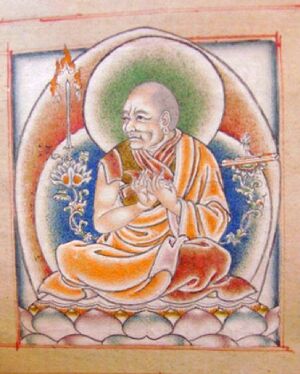Gö Lotsāwa’s Monumental Work on Buddha-Nature[edit]
Gö Lotsāwa Zhönu Pal was one of the most illustrious Tibetan scholars of the fifteenth century, not least for being the author of the famous historical work called Blue Annals. This history gives a brief account of how the five works of Maitreya, including the Ultimate Continuum, were transmitted in Tibet. Although not as well known as his historical work, Gö Lotsāwa also wrote a monumental commentary on the Ultimate Continuum and its vyākhyā entitled The Commentary on the Treatise "Mahāyāna-Uttaratantra": The Mirror Showing Reality Very Clearly. The work, amounting to nearly seven hundred folios, is most likely the longest commentary on the Ultimate Continuum to have ever been written and contains not only detailed philosophical interpretations and arguments but also historical accounts of how the Ultimate Continuum was transmitted in India and Tibet. The text contains rich citations from the canonical texts, including sūtras and tantras, Indian commentarial literature, and the works of many Tibetan scholars and masters. It is almost unique in blending the Indian sources and inspirational Tibetan writings on buddha-nature, particularly from the Kagyu tradition.
Styled on Indian commentarial writings and not laid out using the sa bcad outline which is the norm in Tibetan scholarship, Gö Lotsāwa presents the commentary in three main parts. The title, for which he gives an elaborate explanation of each word, is the first part and is the concise statement through which people of superior caliber can comprehend the content of the text. The second part consists of the first three verses of the Ultimate Continuum, which present the summary of the content of the text. These verses are considered sufficient to give the complete picture of the content of the text for those of middling caliber. The first verse enumerates the seven vajra, or adamantine, topics, which form the content of the Ultimate Continuum, the second verse shows the sūtra sources for these topics, and the third verse presents how the seven topics are connected to each other in a rational and coherent manner.
The third and main part of the commentary is the explanation of the main text of the Ultimate Continuum, in which Gö Lotsāwa first cites the verses and provides a very incisive and detailed explanation. This is said to be required for those of inferior mental caliber. Gö Lotsāwa presents an elaborate commentary on the verses, often exhibiting his ecumenical approach to bring all schools of Mahāyāna thought to a harmonious phase. With his knowledge of Sanskrit, he also compares the different translations and explains some concepts using original Sanskrit terms. For example, he states that the Tibetan term snying po (སྙིང་པོ་) is translated from the Sanskrit terms sāra, hridaya, garbha and maṇḍa. While these can be used synonymously to refer to the same thing, sāra implies being the essence or center from which things emit, hridaya to the heart which is cherished, garbha to the seed or womb which remains at the core, and maṇḍa to the crux or center. His reading of the Ultimate Continuum in his commentary is said to be more aligned to the original Sanskrit than the versions currently available in the Tibetan Tengyur canons.
Another striking feature of his commentary is his merging of the two traditions of the scholastic commentarial tradition, or analytic tradition, passed down from Ngok Lotsāwa Loden Sherab and the meditative tradition passed down from Tsen Khawoche. This is particularly palpable in his writing given his scholastic training under masters such as Tsongkhapa and his deep connection to Mahāmudrā and the Kagyu tradition of Gampopa. While being very critical and scholarly in his exegetical approach, he frequently draws inspiration from the experiential teachings of meditation masters such as Gampopa, Dampa Sangay, and Drigung Kyobpa Jigten Sumgön.
Gö Lotsāwa summarizes the meaning of buddha-nature in the scripture into four categories as (1) emptiness which is a nonimplicative negation, (2) the luminous nature of the mind, (3) the store consciousness, and (4) the bodhisattvas and sentient beings. His own understanding of buddha-nature is aligned to the second one, and he uses terms such as element of awareness (རིག་པའི་ཁམས་) and emptiness of awareness (རིག་པའི་སྟོང་པ་ཉིད་) to refer to buddha-nature, which appears to be seen as a coalescence of emptiness and appearance.
The version of Gö Lotsāwa's commentary which was critically edited by Klaus-Dieter Mathes can be found here.
Weekly quote[edit]
Buddha nature is eternal, pure, real, virtuous, and will be realized by everyone in the future.

